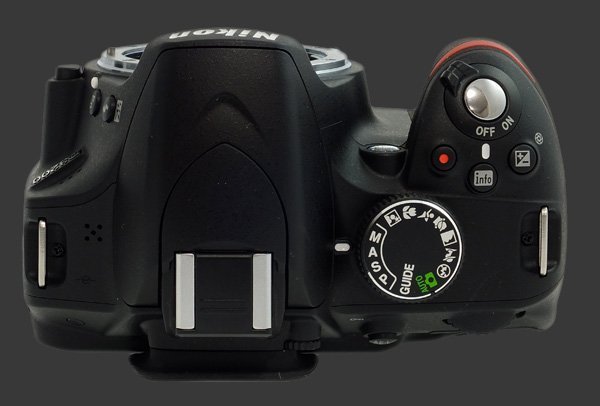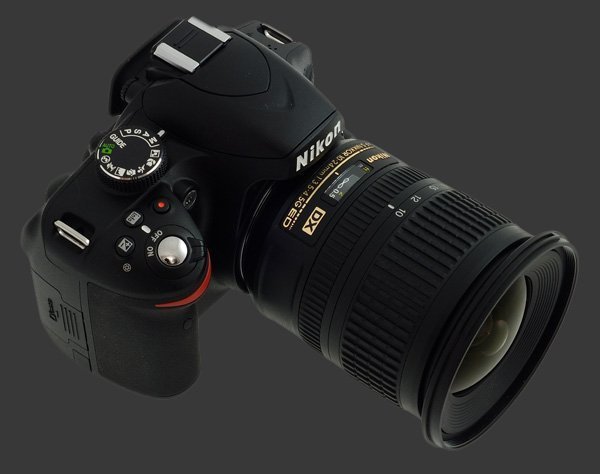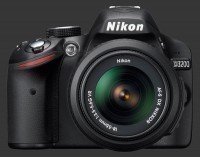Nikon D3200 Review
Nikon D3200 Usability - How easy is it to use?
The ergonomics of the D3200 are good with all controls being placed within easy reach. The hand-grip is quite comfortable and provides a secure hold over the camera. Below the control-wheel on the rear, there is a slight protrusion which prevents the camera from slipping outwards. The Nikon D3200 feels reasonably sturdy.
While gripping the camera, the forefinger can easily reach the EC and Info buttons which are located just behind the shutter-release. New to the D3200 is a video record button which has no effect except in Live-View, pushing the EC button to the side and making it a little awkward. A single control-wheel, located on the camera's rear, adjusts a single exposure parameter. In Manual mode, it controls the shutter-speed when used alone and the aperture when used with the EC button. The AE-L/AF-L button is located within reach of the thumb.

The mode-dial, located on top of the camera, is large with good click-points, making it difficult to accidentally move. The current exposure or scene mode is shown on the Info screen with a small color icon. Pressing the Zoom-Out button brings up a short description of the current mode, as one would guess by the ? next to it. It is nice that the D3200 describes how the camera behaves. For example, in Landscape mode, the screen says "For landscapes and cityscapes. Greens and blues are rendered vividly, with the foreground and background in focus". This implies not only use of a small aperture but also a change in color-rendition, thus overriding the set Picture Control style.
The Nikon D3200 has a unique Guide mode which is a new take on assisted camera settings. It is a hybrid mode blending scene modes and guided operation. The Guide mode is divided into sections for Shooting, View/Delete and Set-up. The view, delete and setup options are short-cuts to common operations for their respective tasks.
The D3200 has a medium-sized penta-mirror viewfinder which provides a relatively bright image. Just below the viewfinder is large 3" LCD with 920K pixels. While the viewfinder is almost flush with the LCD, it has a good eye-point so that you do not have to press against the camera too much.

Below AE-L/AF-L button is the Live-View button. Unlike the more complex one of the D3100, this button simply toggles Live-View on and off. As any camera without a video mode, the camera does not know when it is about to start filming. To help frame video, the Nikon D3200 offers a display mode which darkens the outside of the video recording area. This same mode also displays stereo audio input levels which turn red when sound gets clipped.
Further down is the 4-way controller which is used to select one of 11 focus points in Single-Point AF area mode while shooting using the viewfinder. During Live-View, the 4-way controller moves the focus area in fine increments anywhere around the frame. It is also used to navigate the menu system and information setting screen.
Instead of the great lever to select drive modes on the D3100, the D3200 uses a simple button below and to the left of the 4-way controller. It brings up a six option menu which must be navigated using Up and Down and confirmed by the central OK button. The available options are: Single-Shot, Continuous, Self-Timer, Delayed Remote, Remote and Quiet. While this design is less efficient than a lever, the true problem is that the D3200 resets the self-timer after each use. The duration and number of shots taken by the Self-Timer are controlled by the setup menu. Quiet mode simply moves the mirror slower and delays its return until the shutter is released.
The button to delete images is located all the way down on the body. Tap it twice to delete an image. The delete operation is cancelled if the button is not pressed twice. On the other side of the LCD are 5 buttons: Playback, Menu, Zoom-In, Help or Zoom-Out and Interactive Status Panel.
While the D3200 has a reasonable number of buttons, there are not well used in capture mode. Zoom-In does nothing at all, while the zoom-out button displays a help message. It would be nice if there was easy access to Metering and White-Balance instead. The 4-way controller has no mapped functions either, something which is commonly done. A firmware update could make some of these buttons customizable.

Playback mode is shooting-priority. This means that when the shutter-release is half-pressed, playback is interrupted and the camera is ready to shoot. In playback mode, the control-wheel is used to scroll through images and can do so even while zoomed. This is a crucial feature to compare nearly identical images.
Detailed information on images is available using the up and down directions of the 4-way controller. One push up and a luminance histogram is displayed along with basic exposure parameters and more. Down from there goes back to the image display. One more down push to get RGB histograms. Note that these must be enabled in the Setup menu to be available.
The left side of the camera features two more buttons: Fn and Flash. The Fn can control one of several options, as selected in the menu-system. The Flash button, when used with the control-wheel, cycles through various flash-modes depending on the exposure-mode. When used with the control-wheel and the EC button at the same time, it controls Flash-Compensation.
The rear LCD is typical for this class of camera. It's sharp, clear and has a reasonable anti-reflective coating. The LCD is used to display the Info screen. Pretty much all important settings are available. All changes made using external buttons such as EC, Fn and AE-L/AF-L are echoed to the Info screen which causes unwanted glare while looking through the viewfinder.

In Live-View, the screen provides 100% coverage, which is clearly better than the OVF's 95%. It sadly does not preview exposure, even though things change with EC. Things like shutter-speed and aperture have no effect on the Live-View display. White-balance is previewed. However, since you need to enter the menu system to change it and that hides the Live-View display, it takes a lot of steps to find the correct white-balance. There is a rather noisy Contrast-Detect Autofocus system which is activated by a half-press of the shutter-release. Manual focus is possible in Live-View and the zoom-in and zoom-out buttons can be used to check focus closely.
Movie recording is part of Live-View. Sound is optional. A number of video resolutions are available, all 16:9 widescreen: 1920x1080 (1080p), 1280x720 (720p) and 640x424. 1080p is available at 30 or 24 FPS, while 720p is available at 60 FPS and 640p at 30 FPS. In AF-S mode, focus is performed by half-pressing the shutter-release. What is really nice, is that it can be repeated at any time during video recording. In AF-C mode, the camera tries to focus continuously. Since contrast-detect autofocus is slow, this means the camera spends its time hunting for focus rather than in focus.
The camera itself feels sturdy, even the memory and battery doors feel solid enough. Buttons protrude just enough to be usable with gloves on. There is metal tripod mount in-line with the center of the lens, just like on every other DSLR. One slight ergonomic annoyance is that the camera-strap eyelets cause part of the supplied neck-strap to point get in the way while bringing the camera to eye-level.
 |
Please Support Neocamera
All information on Neocamera is provided free of charge yet running this website is a huge endeavor. Purchases made via affiliate links found throughout the site help keep it running and up-to-date. There is no additional cost to you, so please consider buying via these links to our affilates:
If you found any information on this site valuable and did not purchase via our affiliate links, please considering donating via PayPal:
Any amount will be greatly appreaciated. Thank you for your support!
Nikon D3200 Highlights

Sensor-Size: 24 x 16mm

Actual size when viewed at 100 DPI
| 24 Megapixels DSLR | ISO 100-12800 |
| Nikon F Mount 1.5X FLM | Shutter 1/4000-30s |
| 95% Coverage Small Viewfinder | Full manual controls, including Manual Focus |
| Built-in Dust Reduction | Custom white-balance |
| 4 FPS Drive, 100 Images | Spot-Metering |
| 1920x1080 @ 30 FPS Video Recording | Hot-Shoe |
| 3" LCD 920K Pixels | Stereo audio input |
| Lithium-Ion Battery | |
| Secure Digital Extended Capacity |
Updates
2025.01.18

Fujifilm GFX 2025 Lens Roundup
Lens Review roundup of Fujifilm GFX Medium-Format lenses. Quality, performance and handling of the GF20-35mm F/4R WR, GF30mm F/3.5 Tilt-Shift and the GF55mm F/1.7.
2024.11.18

Best 2024 Photography Gifts for Every Budget
Great gifts for photographers and photo enthusiasts selected for every budget among the best products of 2024.
2024.08.07

Eye Protection Tips for Professional Photographers
The four main considerations for professional photographers regarding eyewear.
2024.07.14

Fujifilm X100VI Review
Flagship fixed-lens compact digital camera with a 40 MP sensor and Image-Stabilization, a first for the series. Retro design featuring dual control-dials, plus direct ISO, Shutter-Speed and EC dials. Its hybrid viewfinder can switch between EVF and OVF mode.
2024.05.09

Fujifilm GFX100 II Review
Flagship 102 Megapixels Medium-Format Mirrorless Digital Camera with 8-Stop 5-Axis IBIS, 8 FPS Drive, 8K Video and 400 MP Super-Resolution capture in a weatherproof and freezeproof body with dual control-dials and dual memory-card slots.
2024.04.03

Fujifilm X-T5 Review
Newest Fujifilm flagship boasting a 40 MP APS-C sensor, 5-axis IBIS with 7-stop efficiency, 15 FPS continuous drive, 6.2K Video capture, dual control-dials and dual SDXC UHS-II slots in a sturdy weatherproof and freezeproof body.
2023.11.20

Best Digital Cameras of 2023
Find out which are the Best Digital Cameras of 2023. All the new Mirrorless Digital Cameras from entry-level to high-end professional.
2023.07.10

Fujifilm X-H2 Review
40 Megapixels APS-C Hybrid Mirrorless Digital Camera with 7-stop IBIS. Fastest shutter ever and 8K video capture. Large builtin EVF with 0.8X magnification and 5.8 MP, plus an Eye-Start Sensor. Packed with features and large number of controls in a weatherproof and freezeproof body.
2023.05.07

Sony FE 20-70mm F/4G Review
Review of the unique Sony FE 20-70mm F/4G lens. The optical zoom of this lens spans ultra-wide-angle and medium focal-length coverage, making it one of the most versatile Full-Frame lenses on the market.
2023.01.15

Huion Inspiroy Dial 2 Review
Review of the Huion Inspiroy Dial 2 tablet, a medium sized drawing surface with dual dials and customizable buttons. Connects via USB-C or Bluetooth 5.0 with Windows, Linux and Android support.
2022.12.08

How to Pack for a Photo Trip
Find out how to pack for a travel photography trip, carry your gear safely while meeting airline regulations.
2022.11.13

Best Digital Cameras of 2022
The best digital cameras of 2022. A short list of the most outstanding models in their respective categories. Choose one for yourself or as a gift.












